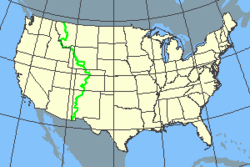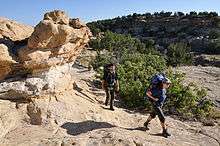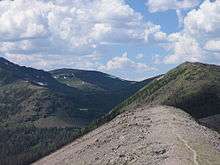Continental Divide Trail
| Continental Divide Trail | |
|---|---|
 | |
| Length | 3100 mi (4989 km) |
| Location | United States |
| Designation | National Scenic Trail in 1978 |
| Trailheads |
Glacier National Park (U.S.) Crazy Cook Monument & Columbus (alternate), New Mexico United States-Mexico border |
| Use |
Hiking some Horse riding some Mountain biking |
| Elevation | |
| Highest point | Grays Peak, Colorado, 14,270 ft (4,350 m) |
| Lowest point | Columbus, New Mexico, 3,900 ft (1,200 m) |
| Hiking details | |
| Months | April to October |
| Sights | Continental Divide |
| Hazards |
Severe Weather Hypothermia Lightning Falls Avalanche Dehydration Bears Mountain lions |
| Website | http://www.continentaldividetrail.org/ |
The Continental Divide National Scenic Trail (in short Continental Divide Trail (CDT)) is a United States National Scenic Trail running 3,100 miles (5,000 km) between Mexico and Canada. It follows the Continental Divide of the Americas along the Rocky Mountains and traverses five U.S. states — Montana, Idaho, Wyoming, Colorado, and New Mexico. In Montana it crosses Triple Divide Peak which separates the Hudson Bay, Atlantic Ocean and Pacific Ocean drainages. The trail is a combination of dedicated trails and small roads and considered 70% complete. Portions designated as uncompleted must be traveled by roadwalking on dirt or paved roads. This trail can be continued north into Canada to Kakwa Lake north of Jasper National Park by the Great Divide Trail, which is so far described only in a few books and carries no official Canadian status.
The Continental Divide Trail along with the Appalachian Trail and the Pacific Crest Trail form what thru-hiker enthusiasts have termed the Triple Crown of long-distance hiking in the United States.
Thru-Hiking
Only about two hundred people a year attempt to hike the entire trail, taking about six months to complete it. Dave Odell thru-hiked in 1977 and in the same year Dan Torpey hiked from the NM/CO border to Mt Robson, Canada. German long-distance rider Günter Wamser (on his way from Tierra del Fuego to Alaska),[1] and Austrian Sonja Endlweber (who joined him for the rest of the journey from Mexico) managed to complete the tour with four Bureau of Land Management mustangs in three summers 2007–09.[2]
In 2007, Francis Tapon became the first person to do a round backpacking trip "Yo-Yo" on the Continental Divide Trail when he thru-hiked from Mexico to Canada and back to Mexico along the CDT and needed 7 months to finish it.[3][4][5][6][7] This seven-month journey spanned over 5,600 miles.[8] Tapon took the most circuitous, scenic, high, difficult route north and while returning south, took the more expedient route.[9] Andrew Skurka completed the trail as part of the 6,875-mile Great Western Loop in 2007.[10]
The youngest person to hike the trail is Reed Gjonnes, who hiked the trail with her father Eric Gjonnes from April 15 to September 6, 2013, at the age of 13.[11][12]
New Mexico

The CDT in New Mexico is about 700 miles (1,100 km) long and some portions have very limited water.[13] Local volunteer groups place water caches (usually a pile of plastic gallon jugs) at strategic points along the trail.[14][15] Three southern termini of the trail exist: 1) Crazy Cook Monument east of the Big Hatchet Mountains, 2) Antelope Wells, New Mexico and 3) near Columbus, New Mexico. All three are located within New Mexico's boot heel. The terminus near Columbus is not on the Continental Divide (see Animas Mountains) but rather in the vicinity of Columbus, a village that is also the northern terminus of the annual 250-mile (400 km) Cabalgata Binacional Villista.
The Crazy Cook Monument is the most commonly recognized starting or finishing point of the Continental Divide Trail, but due to its remote location, devoid of any lodging or other services, Columbus is considered a legitimate alternate starting or finishing point for those hiking or biking the CDT. Located 3 miles from the International Port of Entry at Palomas, Mexico, Columbus is a small border village with several amenities including two modest hotels, a gas station, a handful of small cafes, a US Post Office, a bank, auto mechanics, and grocery stores. Columbus is listed as a National Historic Landmark due to the invasion in 1916 by Pancho Villa and his "Villistas". The village has two museums and a state park commemorating Pancho Villa's raid and the so-called Punitive Mexican Expedition led by US Army General "Blackjack" Pershing, who attempted, but failed to capture him.
From the Crazy Cook Monument (the official southern terminus), the trail begins as a cross-country desire path; the official route up to Lordsburg will be surveyed based around this path at a future date.[16] From Columbus, the route is a roadwalk to Lordsburg.
Notable points on the CDT in New Mexico include:
- Animas and Playas Valleys
- Carson National Forest
- Chama River Canyon Wilderness
- Cibola National Forest
- Cumbres Pass
- El Malpaís National Monument
- Gila National Forest
- Pie Town
- Reserve
- San Pedro Parks Wilderness
Colorado

The CDT passes through many of the highest and wildest mountain regions of Colorado, such as the San Juan Mountains in southern Colorado and the Sawatch Range in the central region. In most areas the trail is well marked. It is concurrent with the Colorado Trail for approximately 200 miles (320 km). The CDT itself meanders in Colorado some 650 miles (1,050 km) at higher altitudes. Depending on any given year’s snow-pack and a hiker’s individual schedule, alternative routes are available. The Creede Cut-off in the San Juan Mountains to avoid persistent snow or unfavorable weather is such an example. This should be balanced with Colorado's 'monsoon season' with afternoon thunderstorms that usually occur in late July and August. The route's location makes short side trips to many of Colorado's 14,000-foot (4,300 m) peaks feasible. A few stretches of the CDT in Colorado have no distinct marked or named trail, but Jonathan Ley's or Jim Wolf's maps are helpful.[17] Some stretches of the CDT in Colorado are still a wilderness footpath.
Additional points of interest along the Colorado CDT include:[18]
- Collegiate Peaks Wilderness
- Grays Peak - highest summit on the CDT
- Mount Elbert and Mount Massive - Colorado's highest peaks
- Rabbit Ears Pass
- Rocky Mountain National Park
- Wolf Creek Pass
- North Park
- Middle Park
- South Park
Wyoming

Of all the five states traversed by the CDT, Wyoming has the most diverse terrain. This includes hiking through a large section of range-land in the middle of the state, known as the Great Divide Basin. Hikers must decide on a route with regard to the Great Divide Basin since the actual Continental Divide forks in southern Wyoming forming in an endorheic basin. The shortest route is through the middle where water availability is uncertain in most years. Farther north the CDT traverses the mountainous 'bench' of the Wind River Range and then through the Absaroka Range in the northwest portion of the state. The grand finale is Yellowstone National Park where the CDT is routed from Yellowstone's southern back country, to Old Faithful and then exits west to Idaho.
Additional notable features in Wyoming include:
Idaho
Northbounders leaving Yellowstone National Park in Wyoming enter the Centennial Mountains of Idaho. For the next couple of hundred miles, the CDT follows the Continental Divide, which is also the boundary between Idaho and Montana. Next the Trail diverts east through the Anaconda Mountain Range toward Butte, Montana.
Notable points on the CDT in Idaho include:
- The alternate route to Macks Inn in Island Park, Idaho.
- Henrys Lake Section
- Resupply in Lima, Montana
- Lemhi Pass
- Chief Joseph Pass
Montana
The Montana portion of the CDT is almost entirely in mountain ranges, running along the Idaho border in the southern portion, before heading east toward Butte and north toward Glacier National Park via the Lewis and Clark National Forest and two National Wilderness areas. Approximately 110 miles (177 km) of the CDT traverses Glacier National Park.
Additional notable points on the CDT in Montana include:
- Anaconda-Pintler Wilderness
- The circle of Butte in the Beaverhead-Deerlodge National Forest
- The Scapegoat Wilderness and the Bob Marshall Wilderness
The Montana Wilderness Association is the leading non-profit partner for the northern section of Continental Divide Trail. MWA staff are working to connect the 980 miles (1,580 km) of CDT in Montana and Idaho with the help of dedicated volunteers and agency partners.[19]
See also
- Other Triple Crown trails
- Connected National Scenic Trail
- Pacific Northwest Trail - Shares a common start/end point with the CDT in Glacier National Park.
- Connected National Historic Trails
- California Trail
- Lewis and Clark National Historic Trail
- Mormon Pioneer Trail
- Nez Perce Trail
- Old Spanish Trail
- Oregon Trail
- Pony Express National Historic Trail
- Connected U.S. long-distance trails
- Colorado Trail - the two trails coincide for about 200 miles (320 km)
- Great Divide Mountain Bike Route - parallel, sometimes shared tread
References
- ↑ Wamser, Günter (2007) Der Abenteuerreiter - In 11 Jahren mit Hund und Pferden von Feuerland nach Mexico Verlag Günter Wamser, 384 pages, ISBN 978-3-00-021527-8.
- ↑ Wamser, Günter / Endlweber, Sonja (2009) Im Wilden Westen - Die Abenteuerreiter unterwegs in den Rocky Mountains Verlag Abenteuerreiter, 432 pages, ISBN 978-3-00-027702-3.
- ↑ Tilin, Andrew. (June 2008) "The Onion vs. Mr. Magoo - On your mark, get set ... hike. Inside a 5,600-mile footrace on the country's hardest trail.". Backpacker Magazine. Retrieved November 2, 2013.
- ↑ M. Biggers, Ashley. (March 2008) "There & Back Again", New Mexico Magazine
- ↑ Bastone, Kelly (August 2008) "Taking the High Way: Thru-hiking the Continental Divide Trail," 5280, pp. 70-73. Denver magazine reports on Francis Tapon's first-ever yo-yo of the CDT.
- ↑ Wilt, Bernie. "PBP Episode 31 - CDT Yo-Yo". PracticalBackpacking.com. Retrieved November 2, 2013.
- ↑ Reese, Janet. (19 June 2007). "5 questions for long-distance hiker Francis Tapon". Rocky Mountain News. Retrieved November 2, 2013.
- ↑ Stienstra, Tom. (March 9, 2008). "Good time to take inventory on gear - and yourself". San Francisco Chronicle. Retrieved November 2, 2013.
- ↑ Manning, John. (April 8, 2008) "Francis Tapon: The first person to yo-yo America’s wildest trail talks heating, eating and the philosophy of lightweight". TGO Magazine. Retrieved November 2, 2013.
- ↑ Duane, Daniel. "2007 Adventurer of the Year: The Walking Man". National Geographic Adventure. Retrieved 2012-02-10.
- ↑ "Salem 13-Year-Old Youngest to Hike Triple Crown". Columbian. 4 Nov 2013.
- ↑ "Ore. Girl, 13, Youngest to Claim Triple Crown". USA Today. 27 Oct 2013.
- ↑ Bob Julyan, Tom Till, William Stone (2001) New Mexico's Continental Divide Trail: The Official Guide Big Earth Publishing, 320 pages, ISBN 1-56579-331-5.
- ↑ "New Mexico". Continental Divide Trail Alliance. May 2008. Retrieved 2008-10-20.
- ↑ "Continental Divide National Scenic Trail". Bureau of Land Management, New Mexico. Retrieved 2008-10-20.
- ↑ Southern Terminus
- ↑ http://www.cdtsociety.org/marketplace.htm
- ↑ <Colorado's Continental Divide Trail by Tom Loranc Jones & John Fielder Apr 2003>
- ↑ "CDT Montana Volunteer Trail Stewardship Program". Montana Wilderness Association. Retrieved 2013-04-20.
External links
- CDT Photo Montage to music by Walkin Jim Stoltz https://www.youtube.com/watch?v=ZUH6CwaemP4&list=UUxmVsgK1kQrIix9lMimKV2Q
- CDT Montana, Montana Wilderness Association
- Continental Divide Trail Society
- Continental Divide Trail Coalition
- Continental Divide National Scenic Trail in Rocky Mountain National Park (National Park Service)
- Jonathan Ley's CDT Hike - a hiker's website
- Beaverhead-Deerlodge National Forest web site - Describes the northernmost parts of the trail
- CDT-L - Continental Divide Trail Mailing List
- Mailing Label Maker - Continental Divide Trail Mailing Label Maker
- CDT Thruhiking Resources - Listing of important resources to thruhike the CDT
- Google Map of CDT High Resolution Google Map of CDT
- A Quick & Dirty CDT Planning Guide - A general overview of the CDT for planning purposes
- Francis Tapon's CDT Yo-Yo hike - a website of the first person who made a round-trip on the CDT
- Hiking Journals from people on The Continental Divide Trail
- Video (04:52) - Hiking the CDT on YouTube